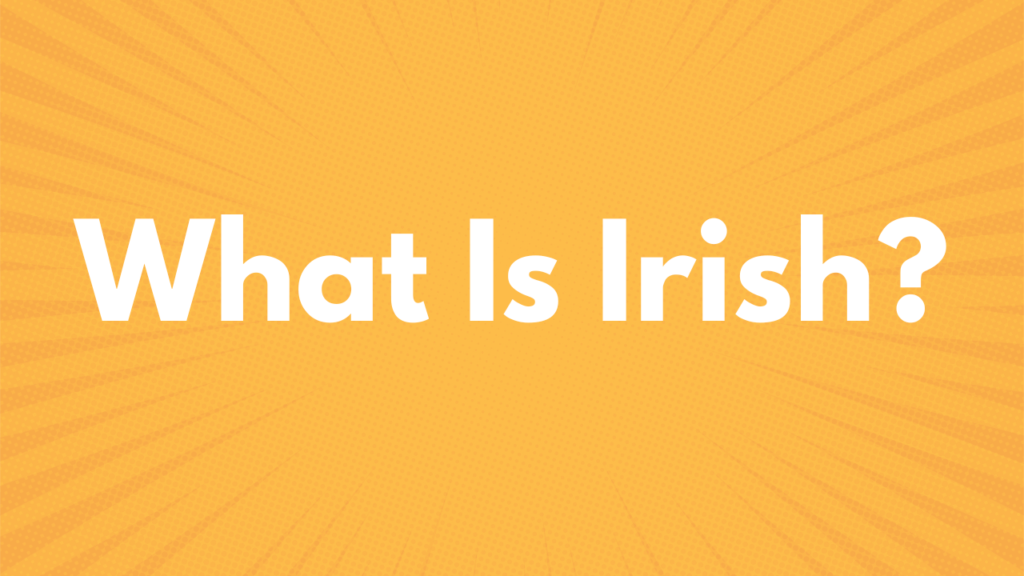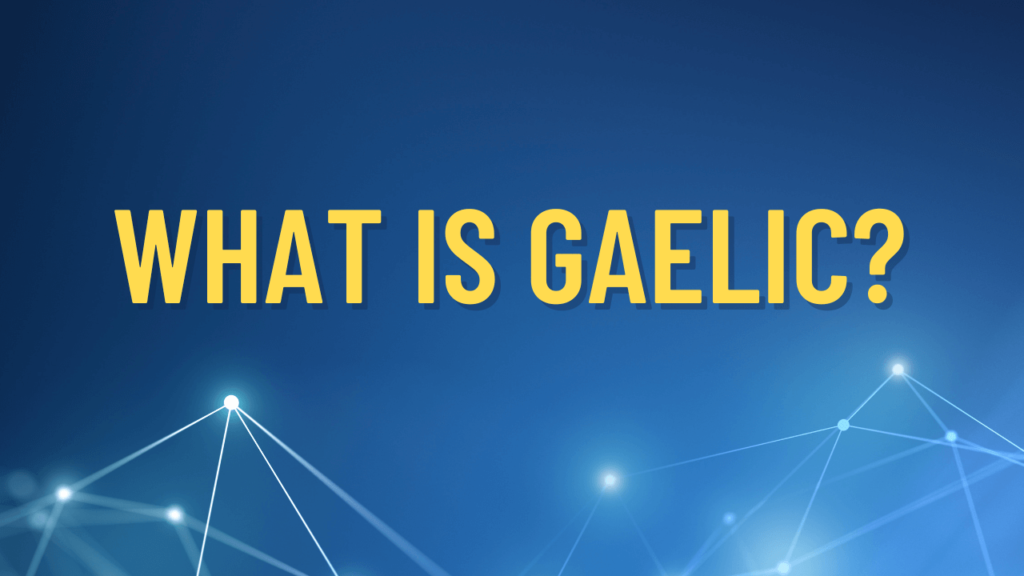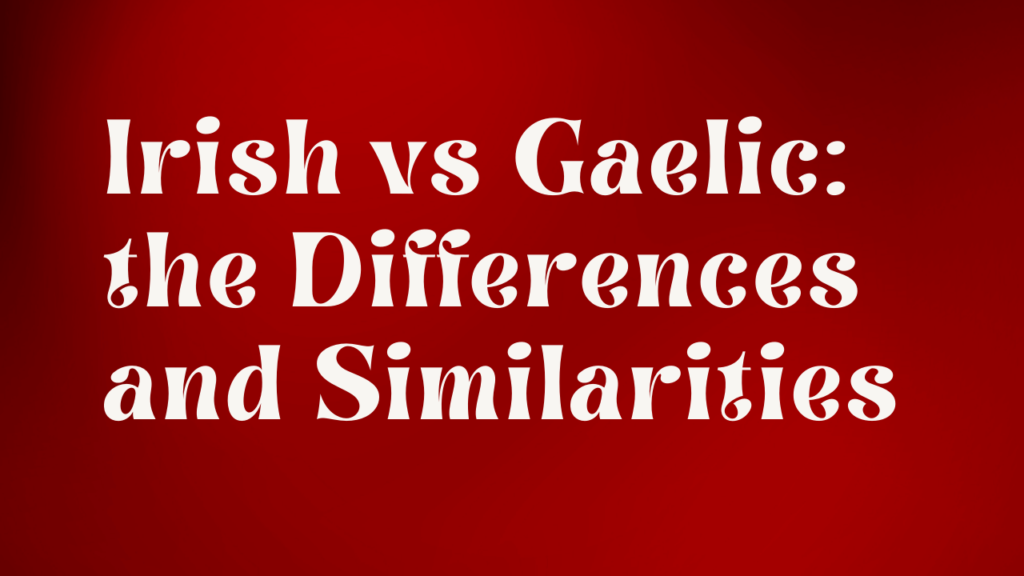When discussing Irish culture and language, two terms often come up: Irish and Gaelic. While they are sometimes used interchangeably, they have distinct meanings and histories. This article will explain the difference between Irish and Gaelic, their origins, uses, and significance in Ireland today.
Quick Comparison: Irish vs Gaelic
| Category | Irish | Gaelic |
|---|---|---|
| Definition | A specific Celtic language spoken in Ireland. | A group of Celtic languages, including Irish, Scottish, and Manx Gaelic. |
| Geographic Scope | Spoken exclusively in Ireland. | Includes Ireland, Scotland, and the Isle of Man. |
| Other Names | Gaeilge, Irish Gaelic. | Scottish Gaelic (Gàidhlig), Manx Gaelic (Gaelg). |
| Cultural Focus | Represents Irish identity and heritage. | Encompasses broader Celtic culture and traditions. |
| Status | An official language of Ireland and the EU. | No single official status; varies by region. |
| Mutual Intelligibility | Not intelligible with Scottish or Manx Gaelic. | Gaelic languages are not mutually intelligible. |
| Alphabet | 18 letters (Latin alphabet). | Variations of the Latin alphabet; spelling differs by language. |
| Modern Usage | Taught in schools, used in media and Gaeltacht areas. | Spoken by small communities in Scotland and the Isle of Man. |
| Historical Origin | Evolved from Old Irish around 4th century. | Evolved from Proto-Celtic, branching into distinct languages. |
| Examples of Use | “Dia dhuit” (hello), “Sláinte” (cheers). | “Halò” (hello in Scottish Gaelic), “Slaynt” (cheers in Manx Gaelic). |
What Is Irish?

Irish, also called Irish Gaelic or Gaeilge (pronounced “gway-luh”), is the native language of Ireland.
Key Points About Irish:
- Definition: A specific Celtic language spoken in Ireland.
- Official Language: It is one of the official languages of Ireland and the European Union.
- Daily Usage: While English is more commonly spoken in Ireland, Irish is still used in some areas called Gaeltacht regions.
- Alphabet: Uses 18 letters from the Latin alphabet, excluding j, k, q, v, w, x, y, and
What Is Gaelic?

The term “Gaelic” is broader and refers to a group of languages that originated from the Celtic people. These languages include:
- Irish Gaelic (Gaeilge) – Spoken in Ireland.
- Scottish Gaelic (Gàidhlig) – Spoken in Scotland.
- Manx Gaelic (Gaelg) – Spoken on the Isle of Man.
Key Points About Gaelic:
- Broader Term: Gaelic is not limited to Ireland; it includes other Celtic languages.
- Cultural Identity: Gaelic represents the culture and traditions of Celtic-speaking communities.
Key Differences Between Irish and Gaelic
| Aspect | Irish | Gaelic |
|---|---|---|
| Definition | A specific language spoken in Ireland. | A group of languages, including Irish Gaelic. |
| Geography | Unique to Ireland. | Includes Ireland, Scotland, and the Isle of Man. |
| Cultural Scope | Focuses on Irish identity. | Encompasses broader Celtic culture. |
| Modern Usage | Actively promoted in Ireland. | Broader term, less commonly used in daily speech. |
History of Irish and Gaelic
4.1. Origins of Irish
- Celtic Roots: Irish evolved from the Celtic languages brought to Ireland around 500 BC.
- Old Irish: The earliest written records date back to the 4th century.
- Influence of Christianity: Monks preserved Irish through manuscripts like the Book of Kells.
4.2. Origins of Gaelic
- Proto-Celtic: Gaelic languages share a common ancestor in Proto-Celtic, spoken by the ancient Celts.
- Spread Across Regions: Gaelic evolved differently in Ireland, Scotland, and the Isle of Man.
Language Features
| Feature | Irish Gaelic | Scottish Gaelic | Manx Gaelic |
|---|---|---|---|
| Pronunciation | Complex, with silent letters. | Different sounds influenced by Scots. | Uses a phonetic spelling system. |
| Grammar | Uses verb-subject-object word order. | Similar grammar to Irish, with differences. | Simplified grammar compared to the others. |
| Dialects | Munster, Connacht, and Ulster. | Regional dialects like Skye or Lochaber. | One main dialect due to revival efforts. |
Modern Usage
6.1. Irish in Ireland
- Education: Irish is a compulsory subject in Irish schools.
- Media: Channels like TG4 and radio stations promote the language.
- Gaeltacht Areas: These regions, such as parts of Donegal and Galway, prioritize Irish as the primary language.
6.2. Gaelic in Other Regions
- Scottish Gaelic: Spoken in parts of Scotland, with around 60,000 speakers. Efforts are being made to preserve it through schools and cultural programs.
- Manx Gaelic: Once considered extinct, Manx Gaelic is experiencing a revival on the Isle of Man.
Common Misconceptions
- Irish and Gaelic Are the Same:
- Irish is a Gaelic language, but not all Gaelic languages are Irish.
- Irish Is Dead:
- Although fewer people speak it daily, Irish is still alive and supported by government initiatives.
- Only Ireland Has Gaelic Culture:
- Gaelic culture extends to Scotland and the Isle of Man as well.
Frequently Asked Questions About Irish vs Gaelic
Q1. What is the difference between Irish and Gaelic?
Answer: Irish is a specific Gaelic language spoken in Ireland. Gaelic, on the other hand, refers to a group of Celtic languages, which includes Irish Gaelic, Scottish Gaelic, and Manx Gaelic.
Q2. Is Irish Gaelic the same as Scottish Gaelic?
Answer: No, Irish Gaelic and Scottish Gaelic are different languages, though they share a common Celtic origin. Over time, they have developed distinct vocabularies, grammar, and pronunciations.
Q3. Do people still speak Irish today?
Answer: Yes, Irish is still spoken, particularly in Gaeltacht areas (Irish-speaking regions). It is also taught in schools and used in Irish media and government.
Q4. Is Gaelic only spoken in Ireland?
Answer: No, Gaelic languages are spoken in Ireland, Scotland (Scottish Gaelic), and the Isle of Man (Manx Gaelic).
Q5. Why is Irish sometimes called Gaelic?
Answer: Irish is part of the Gaelic language family, so it is sometimes referred to as “Irish Gaelic” to distinguish it from Scottish Gaelic and Manx Gaelic.
Q6. How difficult is it to learn Irish Gaelic?
Answer: Learning Irish can be challenging for English speakers due to its unique grammar and pronunciation. However, resources like Duolingo and Irish language courses make it more accessible.
Q7. Why is preserving Irish important?
Answer: Preserving Irish helps maintain Ireland’s cultural heritage, national identity, and historical connection to its Celtic roots.
Q8. What are the Gaeltacht areas in Ireland?
Answer: Gaeltacht areas are regions where Irish is the primary language. These include parts of counties Donegal, Galway, Kerry, and Mayo, among others.
Q9. Can Scottish Gaelic speakers understand Irish Gaelic?
Answer: While there are similarities between the two languages, they are not mutually intelligible. A Scottish Gaelic speaker and an Irish Gaelic speaker would need to learn the other language to communicate effectively.
Q10. What efforts are being made to revive Irish?
Answer: Efforts include teaching Irish in schools, broadcasting Irish media (e.g., TG4), promoting Irish festivals, and government funding for language programs.
Q11. Are Irish and Gaelic written in the same alphabet?
Answer: Both Irish and Scottish Gaelic use variations of the Latin alphabet, but their spelling and accents differ significantly.
Q12. Is Manx Gaelic still spoken?
Answer: Yes, Manx Gaelic is spoken by a small community on the Isle of Man. Though it nearly became extinct, revival efforts have brought it back into use.
Q13. Which language is older, Irish or Scottish Gaelic?
Answer: Irish is older, as it has written records dating back to the 4th century. Scottish Gaelic branched off from Old Irish around the 10th century.
Q14. Is learning Irish mandatory in Ireland?
Answer: Yes, Irish is a compulsory subject in schools in Ireland, though not everyone becomes fluent.
Q15. Can tourists learn basic Irish phrases?
Answer: Absolutely! Many tourists enjoy learning phrases like “Dia dhuit” (hello) or “Go raibh maith agat” (thank you) to enhance their cultural experience in Ireland.
Conclusion
Irish and Gaelic are both integral to Celtic heritage, but they represent different aspects of it. Irish is the national language of Ireland, while Gaelic encompasses a broader range of Celtic languages and cultures. By understanding their differences, we can better appreciate their unique roles in history and modern life.
Let’s celebrate and preserve these rich languages for future generations!

Hi, I’m Tanvir, the founder and author of Explore Ireland Now. With a deep love for Ireland and its rich culture, history, and landscapes, I created this site to share everything that makes this beautiful country worth exploring. Whether you’re a local looking for hidden gems or a traveler planning your next adventure, I provide insightful guides, tips, and recommendations to help you experience Ireland to the fullest.
From stunning landscapes to vibrant cities and quaint villages, Ireland is full of wonders waiting to be discovered. Through my personal experiences and research, I aim to bring you the most up-to-date information and inspiration for your journey.
Thank you for visiting Explore Ireland Now—I hope my content helps you uncover all that this incredible country has to offer! If you have any questions or need travel advice, feel free to reach out.



